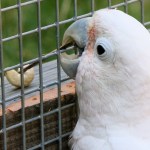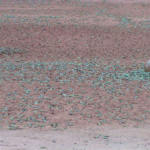avian
This is such a beautiful award-winning image of the complex vascular networks in a pigeon. The image was captured using CT scan technology and a novel contrasting agent called BriteVu that allows visualization of even tiny capillaries. This image was captured by Scott Echols who is a member of the Grey Parrot Anatomy Project, whose goals are to create technologies to study animal anatomy. The complex capillary network located in the neck of this pigeon is important in helping the animal regulate body temperature. Dilation of these blood vessels allows the birds to…
Check out this picture of a captive cockatoo (Cacatua goffiniana) in the Department of Cognitive Biology at the University of Vienna using a tool:
Image from: Scientific American
Figaro (shown above) was observed by a student using a piece of bamboo to try to retrieve a dropped pebble. This was the first documented evidence of a Goffin's cockatoo attempting to use a tool so the researchers decided to try a little experiment. They placed a cashew just outside of Figaro's cage and observed as Figaro attempted to retrieve it using a stick he found on the floor of the aviary. When that was…
Blair Wolf is an associate professor of biology at the University of New Mexico. Research in the Wolf lab focuses on the natural history and ecophysiology of desert animals. He agreed to blog with Dr. Dolittle on the topic of birds. Here is the final excerpt from their exchange.
PHOTO: Budgerigars keeping cool under the shade of a patio during an Australian heat wave, courtesy of Dr. Blair Wolf.
Dr. Dolittle: Would you predict that with global warming, the average body size of birds will increase in hotter areas like the southwestern United States and Australia? Why? What will this mean to…
Blair Wolf is an associate professor of biology at the University of New Mexico. Research in the Wolf lab focuses on the natural history and ecophysiology of desert animals. He agreed to blog with Dr. Dolittle on the topic of birds. Here are excerpts from their exchange.
Dr. Dolittle: What made you interested in studying the effects of Australian heat waves on bird populations?
Dr. Wolf: Australia has a very challenging environment, with a great expanse of hot desert and seems to be THE poster child for the bad things that are associated with climate warming. The continent has recently…
Blair Wolf is an associate professor of biology at the University of New Mexico. Research in the Wolf lab focuses on the natural history and ecophysiology of desert animals. He agreed to blog with Dr. Dolittle on the topic of birds. Here is an excerpt from their exchange.
Dr. Dolittle: Much of your recent research has taken place in the southwestern United States. Do you predict that similar heat waves will occur in this region? Why?
Dr. Wolf: The most current climate research suggests that the southwestern United States is going to get quite a bit hotter and dryer in the next 80 or so years…
Blair Wolf is an associate professor of biology at the University of New Mexico. Research in the Wolf lab focuses on the natural history and ecophysiology of desert animals.
Preface: Dr. Blair Wolf's research discussed in a previous blog released August 13, 2010 on what causes the mass deaths of budgerigars (small birds in Australia) during heat waves sparked much discussion.
PHOTO: Budgerigars killed by a heat wave near a dried-up pond courtesy of Dr. Blair Wolf.
PHOTO: Budgerigars killed by a heat wave in Australia courtesy of Dr. Blair Wolf.
As a result of this discussion I decided to…
tags: Birds in the News, BirdNews, ornithology, birds, avian, newsletter
Zebra Finch, Poephila guttata.
Image: orphaned [larger view].
Birds in Science
Low-quality females prefer low-quality males, at least in the avian world. This is according to research published in the Royal Society journal Proceedings B, testing female zebra finches' taste in males. As adults, the low-quality females showed a preference for the songs of males of the same quality, and for the male birds themselves. Evolutionary biologists previously thought that females would always opt for the best male available.
A…
tags: Birds in the News, BirdNews, ornithology, birds, avian, newsletter
"Magpie Menace"
Pete Marshall, 2009, Oil [larger view].
Birds in Science
By genetically modifying the brains of songbirds for the first time, scientists may have a devised useful new tool for studying neurological growth and healing in humans. "Songbirds have become a classic tool for studying vocal learning and neuron replacement. This will bring those two topics into the molecular age," said neuroscientist Fernando Nottebohm of Rockefeller University, author of a study published recently in the Proceedings of the…
tags: Birds in the News, BirdNews, ornithology, birds, avian, newsletter
Fiji (MacGillivray's) Petrel, Pseudobulweria macgillivrayi, off Gau Island, Fiji.
Fiji Petrel Pelagic Expedition, May 2009.
Image: H. Shirihai, Tubenoses Project [larger view].
Birds in Science News
Maori legends told of a giant predatory bird called the Te Hokioi, whose wingspan approached the length of a full-grown man and whose prey included human beings. Now Kiwi scientists are adding to the legend by claiming that a skeleton found in the 1870s shares some of the legendary bird's traits. "We don't think it…
tags: Birds in the News, BirdNews, ornithology, birds, avian, newsletter
Sandwich Tern, Sterna sandvicensis, photographed at the Bolivar Ferry, Texas.
Image: Joseph Kennedy, 4 August 2009 [larger view].
Birds and Technology
Rather than searching for weird weather or enemy missiles, some satellites are helping researchers to track -- and predict -- the spread of deadly diseases. With the pandemic spread of H1N1 swine flu and the continued advance of the H5N1 avian flu, scientists are anxious to better predict the spread of infectious diseases and are looking for new tools wherever they…
tags: Birds in the News, BirdNews, ornithology, birds, avian, newsletter
Black-crowned Night-Heron, Nycticorax nycticorax, photographed at Brazos Bend State Park, Texas.
Image: Joseph Kennedy, 7 August 2009 [larger view].
Nikon D200, Kowa 883 telescope with TSN-PZ camera eyepiece 1/180s f/8.0 at 1000.0mm iso400.
Birds in Science
Brainy male birds are more sexually attractive to female birds, scientists have discovered. Researchers gave male bowerbirds a set of cognitive tests to evaluate their problem solving ability. Bowerbirds that performed well in the tests also mated with the most…
tags: Birds in the News, BirdNews, ornithology, birds, avian, newsletter
A once-in-a-lifetime photograph of a Common (Eurasian) Kingfisher, Alcedo atthis.
Image: orphaned [larger view].
Birds in Science
For centuries, scientists have puzzled over why the toucan's bill is so remarkably large -- but now one team thinks it might have an answer. The researchers say that the toucan uses its enormous beak to stay cool. They used infrared cameras to show the bird dumping heat from its body into its bill, helping it to regulate its body temperature. The toucan has the largest bill of any bird,…
tags: Birds in the News, BirdNews, ornithology, birds, avian, newsletter
Birdwatchers in southeastern Australia have been thrilled to see the arrival of about a third of the total national population of the highly endangered Swift Parrot, Lathamus discolor, on the Far South Coast.
Image: Max Sutcliffe, Narooma News [larger view].
Birds in Science
Bird deaths around the Baltic Sea and possibly elsewhere in the world may be caused by a shortage of the vitamin thiamine, researchers say. Wild birds of varied species along the Baltic coasts have been dying of hard-to-explain paralysis since…
tags: Birds in the News, BirdNews, ornithology, birds, avian, newsletter
Plump and hoping to get plumper, a red knot takes a break from eating horseshoe crab eggs at Mispillion Harbor.
Image: Louisa Jonas/WYPR [larger view].
Birds in Science
Catching adult eagles for research purposes is no easy task, but a Purdue University researcher has found a way around the problem, and, in the process, gathered even more information about the birds without ever laying a hand on one. "Many birds are small, easy to catch and abundant," said Andrew DeWoody, associate professor of forestry and natural…
tags: Birds in the News, BirdNews, ornithology, birds, avian, newsletter
The first Seychelles Paradise-flycatcher chicks, Terpsiphone corvina,
to fledge successfully outside La Digue Island, Seychelles for over 60 years
are flying on Denis Island.
Image: David Hosking [larger view].
Birds in Science
One of the fifteen Frisian 'transmitter godwits', which was still in Friesland on one week ago on Saturday, arrived in Senegal in West Africa on Tuesday morning. The bird, nicknamed Heidenskip, appears to have flown from Friesland via Spain and over the Sahara in one go. The distance, over…
tags: Birds in the News, BirdNews, ornithology, birds, avian, newsletter
Gyrfalcon chicks in 2500 year-old nest in Greenland. Gyrfalcons are the largest species of falcon in the world.
Image: Jack Stephens.
This edition of Birds in the News is dedicated to Bob, Asa, Neil and Biosparite in honor of their kind $upport. I deeply appreciate your generosity and thoughtfulness.
Birds and Science
Why aren't birds larger? Fifteen-kilogram swans hold the current upper size record for flying birds, although the extinct Argentavis of the Miocene Epoch in Argentina is estimated to have weighed 70…
tags: Birds in the News, BirdNews, ornithology, birds, avian, newsletter
Boreal or Tengmalm's Owl, Aegolius funereus.
Boreal Owls are circumpolar, occupying subalpine and northern, or boreal,
forests around the globe. These seasonally monogamous birds nest in small
cavities; woodpecker holes, other natural tree cavities, or man-made nest boxes.
These small owls occasionally irrupt from their northerly homes in search of food.
Image: orphaned [larger view].
This edition of Birds in the News is dedicated to Snowflake and Biosparite, and to Miriam, whose $upport was inspired by Birds in the…
tags: Birds in the News, BirdNews, ornithology, birds, avian, newsletter
Common Kingfisher, Alcedo atthis.
Image: Gisela Delpho [larger view].
Birds in Science
Unpredictable weather seems to stimulate chatter among birds -- as well as humans -- according to researchers. A team of US scientists has found that Northern Mockingbirds living in variable climates sing more elaborate songs. Complex tunes, sung by males to impress females, are likely to signal the birds' intelligence. Carlos Botero, a researcher from the National Evolutionary Synthesis Center in North Carolina, led the study. Dr…
tags: Birds in the News, BirdNews, ornithology, birds, avian, newsletter
Who's shooting endangered condors?
The shooting of two rare California condors, like this one, set phones ringing at the offices of environmental groups.
Image: [larger view].
Birds in Science
Northern Mockingbirds tend to sing fancier tunes with changing climate, say researchers. The research team from the National Evolutionary Synthesis Centre (NESCent), the Cornell Lab of Ornithology, and McGill University showed that species in more variable climes also sing complex tunes. "Survival and reproduction become more…
tags: Birds in the News, BirdNews, ornithology, birds, avian, newsletter
Lear's Macaw, Anodorhynchus leari: a great example of a conservation success story.
Image: Andy and Gill Swash, World Wildlife Images.
Birds in Science
A record number of bird species are now listed as threatened with extinction, a global assessment has revealed. The IUCN Red List evaluation considered 1,227, or 12%, of all known bird species to be at risk, with 192 species described as Critically Endangered. The main threats affecting bird numbers continued to be agriculture, logging and invasive species, the…




